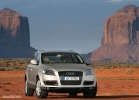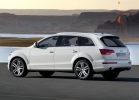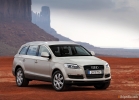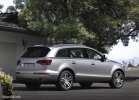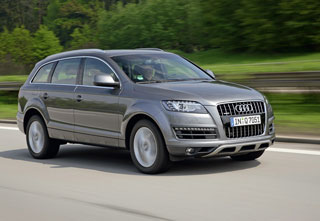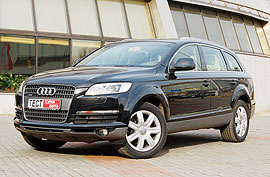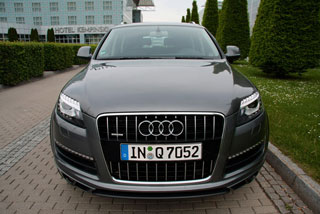Test drive Audi Q7 2006 - 2009 SUV
Audi Q7. Vertical power
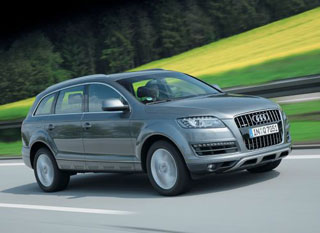 Audi Q7. Price: from 51750. On sale: August 2009.
Audi Q7. Price: from 51750. On sale: August 2009. The design of the most powerful diesel SUV in the world, new options and modernized engines all this is updated Audi Q7
Test pilot
Maxim Fedorov, 31 years old, automobile journalist, driving experience 6 years, personal car - Ford Focus II
The vertical ribs of the radiator lattice were previously a distinctive feature of the most expensive version of the Kushka with a 500 -horsepower V12 TDI, which still has no equal power among serial diesel SUVs. In the updated Q7, these ribs, as well as LEDs in the rear flashlights and threads of LED dwellings in the front air intakes, became the property of all modifications, including the most budgetary ones, which cost half as much as a 12-cylinder top model. At the same time, any version of the Ingolstets crossover can be added by replacing the full-time 18-inch alloy wheels with the casting of the 21st-inch dimension and installing adaptive bixenon headlights in which the dimensions of the dimensions are performed by P-shaped brackets of LEDs. In addition, now for 8 -cylinder modifications you can order ceramic thoromose discs, which were previously part of the exclusive equipment of the Audi Q7 V12 TDI.
Acquaintance with the novelty, which took place in Munich, I started with a 4.2 -fraud version. The acceleration of this model refreshed the sensations experienced a few hours before the test drive in the Airbas chair, with the only difference that the sound of the 8-cylnate engine Audi Q7 is more pleasant than the jealous turbines of the airliner. Thanks to the successful settings of the adaptive steering electric power steering, even at speeds close to maximum, you do not experience problems with holding the car on the desired trajectory. At the same time, radar cruise control helps not to get out of the limit in the speeds with speed restriction, which automatically withstands a safe distance to the running car.
When it was time to try out the version with another engine, I asked for 4.2 TDI diesel. But in response, the keys to the same car on which I just arrived! Complete silence in the diesel Audi Q7 salon was confused to the end of the trip, I was sure that he had a 4.2 fsi gasoline under his hood! However, there is nothing to be surprised here: thanks to a good soundproofing of the salon and the minimum difference in power (340 hp. 4.2 tdi against 350 hp in 4.2 fsi) can only be distinguished by these engines in the hands: the diesel version accelerates to 100 km /h in 6.4 seconds, for a second faster than gasoline.
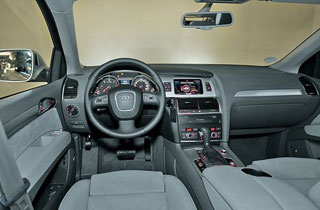 Crossing the wheel of 240 -horsepower Audi Q7 3.0 TDI, I was sure that on the road this model would not show the same agility as more powerful versions of the Kushka. But my expectations did not live up to. The three -liter modification turned out to be surprisingly Shustro, and in terms of controllability I liked even more than versions with 4.2 -litrous eights! Although the equipped mass of these modifications differs slightly, subjectively Audi Q7 3.0 TDI passes easier. At the same time, the car pleases with a very good dynamics (8.5 seconds to hundreds), and its 6 -cylinder turbodiesel spends a little more than 9 liters of diesel fuel per 100 km in a mixed cycle.
Crossing the wheel of 240 -horsepower Audi Q7 3.0 TDI, I was sure that on the road this model would not show the same agility as more powerful versions of the Kushka. But my expectations did not live up to. The three -liter modification turned out to be surprisingly Shustro, and in terms of controllability I liked even more than versions with 4.2 -litrous eights! Although the equipped mass of these modifications differs slightly, subjectively Audi Q7 3.0 TDI passes easier. At the same time, the car pleases with a very good dynamics (8.5 seconds to hundreds), and its 6 -cylinder turbodiesel spends a little more than 9 liters of diesel fuel per 100 km in a mixed cycle. Who has a thicker wallet?
After the exterior Audi equalized the rights of the owners of various modifications of the Kushka, now, in order to show their steepness, the owner of the Ingolstadt crossover will have to demonstrate a salon, the possibilities of which are limited only to the thickness of the customer’s wallet. For a fee, here you can install a 14 -channel audio system from the Danish professors of the sound of Bang & Olufsen, the capacities of which will be enough to fill the whole stadium with a high -quality sound. Moreover, the columns of this system provide not only sound, but also a visual effect: for example, when the engine is launched from the bowels of the front panel, low -frequency watches rise in the form of a sand clock. The beauty! By the way, the front panel of the updated Q7 can now be covered with leather, and the ceiling is overwhelmed with Alcantara. The interior can also be applied due to aluminum linings on the thresholds, LED backlighting doors and space in the legs of the front passengers, as well as ventilated front seats. In total, a dozen interior trim packages is offered for the model, including three types of skin and various skin combinations with Alcantara. At the same time, all versions of the Audi Q7 with the number of engine cylinders are regularly on the skin.
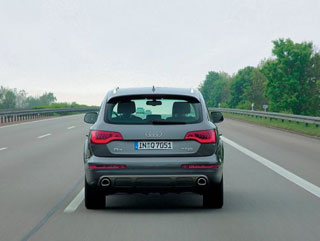 Driving
Driving For its mass and dimensions, the car is well controlled and pleases with excellent course stability.
Salon
It is richly equipped in the database: there is a climate, MMI media system, and with the V8 engine also a leather salon.
Comfort
Adaptive air suspension provides excellent smoothness, not worsening handling. True, it is regularly placed only on version 4.2 TDI and 6.0 TDI.
Security
The prerestyling version received 4 euro ncap stars.
Price
Adequate.
Advantages and disadvantages
+ High level of comfort, excellent quality of the finish, a rich list of standard equipment, powerful and economical diesel engines.
- Lack of full -sized spare wheel, uncomfortable management of the MMI media system.
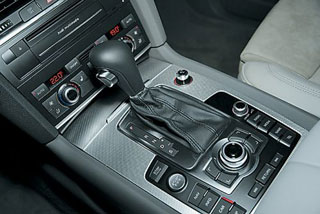 Specifications
Specifications Mark and model - Audi Q7 3.0 TDI
Dimensions - 5089x1983x1737 mm
Engine-diesel, V-shaped, 6 cylinders, 2967 cm3, 240 hp/40004400 min-1
Transmission - automatic, 6 -speed
Dynamics - 210 km/h; 8.5 s to 100 km/h
Competitors - BMW X5, Infiniti FX, Mercedes -Benz ML.
Our opinion
Having minimized visual differences between the most expensive and most affordable versions of the Audi Q7, the creators of the updated model have made a bet on a wide selection of interior options and options that allow you to individualize the appearance of the crossover in their taste and size of the wallet.
Author: Maxim Fedorov
A source: Magazine 5 wheel [July 2009]
Video test drives Audi Q7 2006 - 2009
Video crash tests Audi Q7 2006 - 2009
Audi Q7 2006 test drives - 2009
Crash Test Audi Q7 2006 - 2009
Krassh Test: Detailed Information30%
Driver and passengers
15%
Pedestrians
39%
Children-passengers

